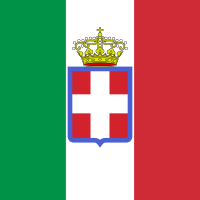Royal Italian Army during World War II
|
Armed Forces of the Empire of Italy Regio Esercito |
|
|---|---|

Flag of Italy with the emblem of Savoia.
|
|
| Active | 1861–1946 |
| Country |
|
| Allegiance | Kingdom of Italy |
| Role | Armed forces of Kingdom of Italy |
| Size | 3,000,000 (1939) 6,000,000 (1943) |
| Anniversaries | November 4 |
| Engagements | World War II |
| Commanders | |
| Ceremonial chief | King of Italy and Prime Minister |
| Notable commanders |
Benito Mussolini Vittorio Emanuele III Vittorio Emanuele II Pietro Badoglio Luigi Cadorna Armando Diaz |
This article is about the Italian Royal Army (Regio Esercito) which participated in World War II.
The Italian Royal Army was reformed in 1861 and lasted until 1946. The Royal Army started with the unification of Italy (Risorgimento) and the formation of the Kingdom of Italy (Regno d'Italia). It ended with the dissolution of the monarchy. The Royal Army was preceded by the individual armies of the various independent Italian states and was followed by the Italian Army (Esercito Italiano) of the Italian Republic (Repubblica Italiana).
The Italian Army of World War II was a "Royal" army. The nominal Commander-in-Chief of the Italian Royal Army was His Majesty King Vittorio Emanuele III. As Commander-in-Chief of all Italian armed forces, Vittorio Emanuele also commanded the Royal Air Force (Regia Aeronautica) and the Royal Navy (Regia Marina). However, in reality, most of the King's military responsibilities were assumed by the Italian Prime Minister Benito Mussolini.
Below Mussolini was the Supreme Command (Comando Supremo). The Supreme Command featured an organic staff which functioned through its defense ministries and through its various high commands. The defense ministries were based on function and included a Ministry of War, a Ministry of the Admiralty, and a Ministry of the Air. The high commands were based on geographic regions and included Army Group West, Army Group Albania, Army Group East Africa, Army Group Aegean, and Army Group Libya.
...
Wikipedia
